
|
Olympus E-300 Image Samples |

|
My other articles related to the |
|
Here are some image samples from the Olympus E-300 digital camera equipped with the bundled 14-45/3.5-5.6 zoom lens. On the left I'm showing full frames, reduced and resharpened, then saved as "economy" JPEGs, with red rectangles showing locations of 1:1 samples. The latter are shown on the right, without any postprocessing at all (except for cropping and re-saving at low compression, that is). All shots were taken in the native, 8 MP size. Because of the simple focal length equivalence ratio equal to 2.0, I'm not showing the EFL (35-mm equivalent focal length), quoting just the actual focal length, F. Just multiply it by two to get the EFL. Before going through the samples make sure that your monitor is more or less calibrated; otherwise you'll be wasting your effort (and mine). Also, remember that all image flaws are exaggerated in these samples: the sample height corresponds to 33 mm (1.3") in a 30x40 cm (12x16") print; the chances are that you are viewing the images magnified by two from that print size! My standard samples: the Crofton pond This is a frequent subject of my samples, as all I need is to walk 50 feet out of my front door. A cold but sunny, December afternoon (just before 3 PM); all pictures shot from hand and with the lens wide open. |
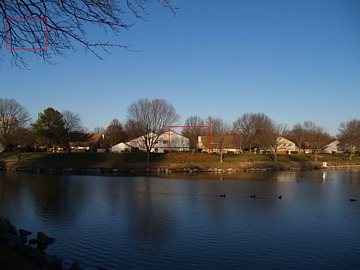
|
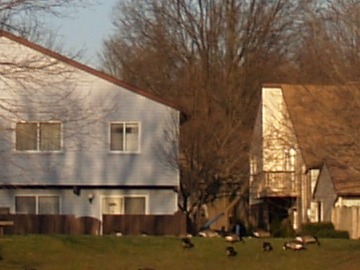
| |
| F = 14 mm, aperture priority (±0 EV): 1/1000s at F/3.5, ISO 100, compression 1:2.7; all other settings at default. |
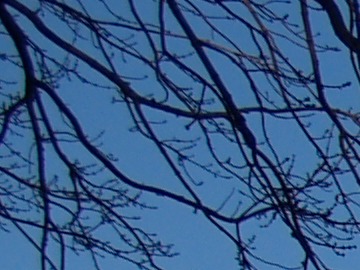
| |
|
Very nice: colors and exposure right on the nose; good tonal range (which you will appreciate only if your monitor is calibrated OK).
Overall sharpness is good, better than I expected with an inexpensive lens. Close inspection of the whole image (5.4 MB) reveals some softening away from the center, best visible in the branches of the leftmost tree on the far shore, not really objectionable. You can also see some slight vignetting in the corners, but just a hint of it. | ||
|
Some excessive sharpening (white bounce) is visible at the roof line (top) and in the branches (bottom); in the latter case there is also just a hint of chromatic aberration, far from objectionable (it may be more of a problem against a paper-white sky, but the weather is too nice now in Maryland). To see if the oversharpening can be avoided, here is the same scene shot at the same settings, except that sharpening was at -2 and contrast at -1. |
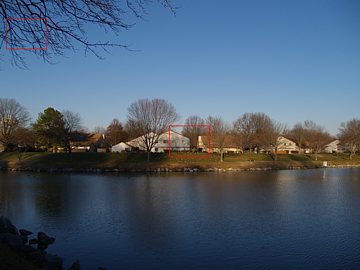
|
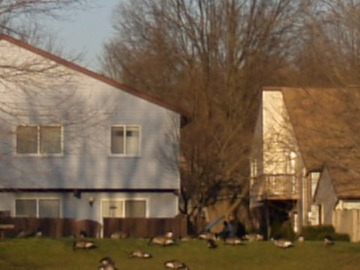
| |
| F = 14 mm, aperture priority (±0 EV): 1/1000s at F/3.5, ISO 100, compression 1:2.7; contrast at -1, sharpness at -2; everything else at default. |
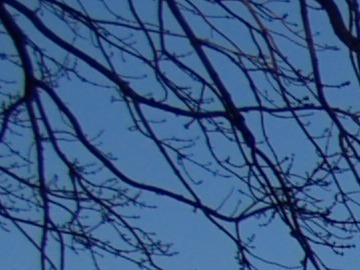
| |
|
Both at the roof line and in the branches the situation is now better; the oversharpening is gone or almost so.
While the branch contours look slightly less sharp, the effect is more natural and I prefer it this way. | ||
|
The differences are best visible when comparing a pair of pictures in a good image browser, like ACDSee, where you can lock zoom and pan, and then flip from one frame to another and back, zoomed on exactly the same fragment. You will then see things not easy to notice when viewing the same pictures side by side. Generally, I think I will use these sharpness and contrast settings as defaults with this camera. Now, let us move on to longer focal lengths. Once again, very good, except that the grass area shows symptoms of too aggressive dynamic noise filtering. See for yourself. |
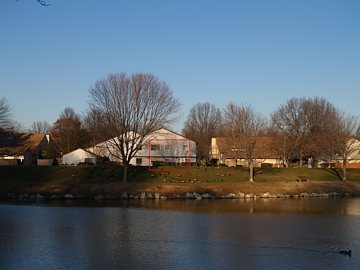
|
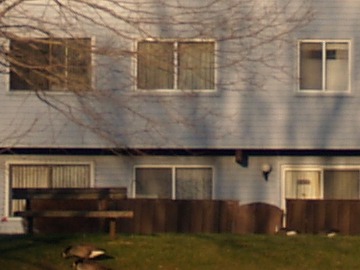
| |
| F = 25 mm, program exposure (±0 EV): 1/800s at F/4.2, ISO 100, compression 1:2.7; all other settings at default values. | ||
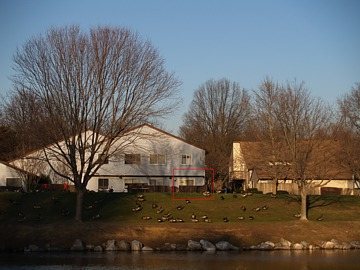
|
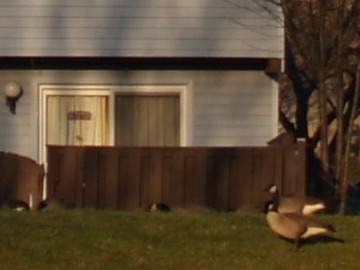
| |
| F = 45 mm, program exposure (±0 EV): 1/500s at F/5.6, ISO 100, compression 1:2.7; all other settings at default. The full image can be found here. | ||
|
I also shot the same scene using the pre-set landscape program (referred to by Olympus as "scene mode"). This mode seems simply to increase contrast and color saturation; if and when I have time, I'll devote a separate small article to this subject. Office park in suburban Maryland This was my first series of sample shots, taken in a business park in suburban Maryland, where I earn my money to buy all these cameras. |
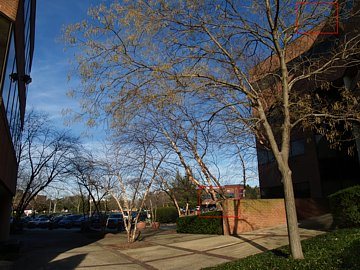
|
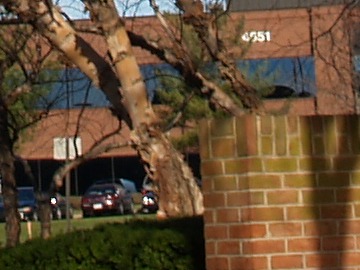
| |
| F = 14 mm, program exposure (±0 EV): 1/200s at F/9.0, ISO 100, compression 1:4; all other settings at default values. |
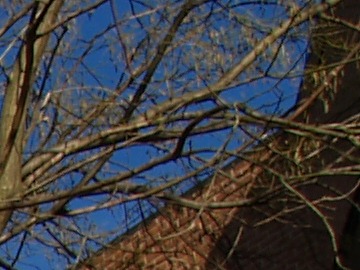
| |
|
Everything just fine, good sharpness in center and corners. Close inspection shows some detail in deep shadows. No visible chromatic aberration yet.
The top of the green hedge in the second sample shows some fuzziness, a symptom of too aggressive dynamic noise filtering. Overall, a respectable job again, somewhat marred by an unfortunate choice (noise filtering) made in the firmware. | ||

|
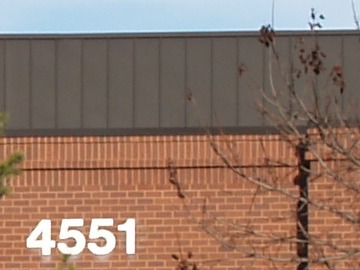
| |
| F = 45 mm, program exposure (±0 EV): 1/200s at F/9.0, ISO 100, compression 1:4; all other settings at default. |

| |
|
Maybe a tad softer, normal for a long focal length, still OK. No fringing or chromatic aberration at the border of the burnt-out building number. (Avoiding the burnout was not worth losing the shadows.)
Notice the excessive sharpening (white bounce) at the roof top in the same sample. Again, setting sharpness to set -2 would help. | ||
|
Bonus: my world-famous license plate In a celebration of a major discovery (last week I discovered my Maryland driver's license expired almost two years ago), here is my regular subject used for lens evaluation samples: my license plates (the car is not washed, sorry). Here I'm shooting with the lens wide open, i.e., at maximum aperture. I'm showing only 1:1 samples from the center, but the corners are also good; checked on some other images. |
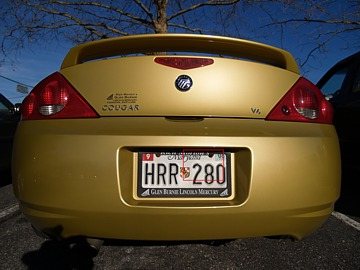
|
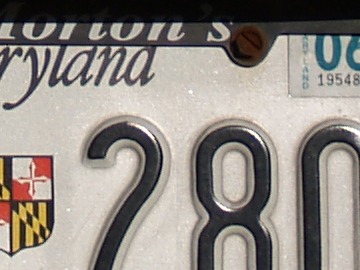
| |
| F = 14 mm, aperture priority (-0.3 EV): F/3.5, 1/3200 s (!), ISO 100; all other settings at default. | ||
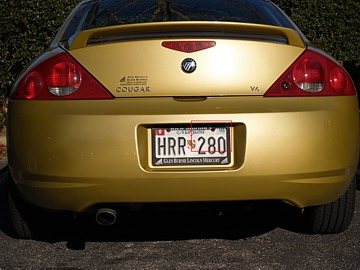
|
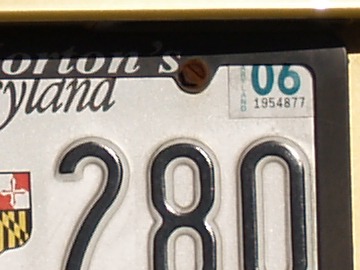
| |
| F = 39 mm (oops! it was supposed to be 45 mm!), aperture priority (±0 EV): F/5.2 (wide open), 1/1250 s, ISO 100; all other settings at default. | ||
|
Now, aren't we impressed? Let me remind you again that on a typical monitor the samples are twice as large as they would look in the full frame enlarged to 30x40 cm (12x14"). And no, I haven't used a polarizer here. Actually, it looks like this modest lens is quite capable to take advantage of the 8 MP resolution of the E-300. (Coming back to my discovery: I had to get a brand-new license, and the process included the regulations exam and driving test. Imagine that?) Snow! Snow! Snow! We had the Blizzard of 2005 in Maryland, a good opportunity to see how the camera's AE system handles the highlights. Here is yours humbly, braving the -8° Celsius chill, taking a picture of his neighborhood's parking lot, and wishing only to retire back to his living room with a snifter of brandy... |
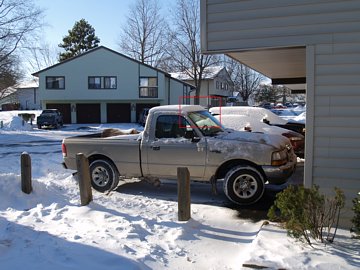
|
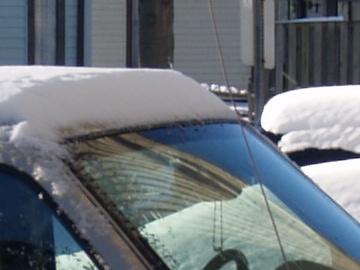
| |
| F = 18 mm, program exposure (-0.3 EV), ISO 100: 1/160 s at F/8; contrast at -1, sharpness at -2; all other settings at default. | ||
|
Not bad: highlights under control, white balance OK (assuming your monitor is calibrated; on my laptop, which is not, the picture looks too blue, but on the desktop, which is, it looks really nice). Most other snow samples from that session turned OK as well, except for two, with lots of bright areas, where the AE system overcompensated; these two required some histogram stretching to rise and shine. Close-up, warm fluorescent light, long exposure Here is a quite demanding shot. One of the prettiest SLR cameras ever made, an Exakta Varex IIa from mid-Sixties, equipped with the famous Biotar 1.5/75 lens (which may be worth more than the whole E-300), was photographed under household, warm fluorescent lights filtered with white paper lamp shades. To provide a good depth of field I stepped the lens down to F/16, which required an exposure time of four seconds. |
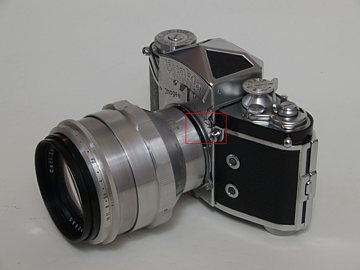
|
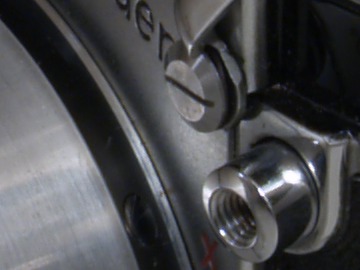
| |
| F = 45 mm, aperture priority with (±0 EV): 4 s at F/16, ISO 100, compression 1:4; white balance by reference; all other settings at default. Click here for the full image. | ||
|
The lens and camera did a good job here (better than the photographer, see below). The sharpness is good (the far dial is out of depth of field, don't blame the lens for that), and the white balance, set by reference, is neutral, as it should be. With the bright metallic lens and white background, I should have used some positive exposure compensation (about 1 EV), but the camera did here what it could (and should). The scene brightness, at EV 6, was still well within the nominal metering range of the E-300. The noise, in spite of the long exposure time, is not really visible, although I suspect it to be, again, rather aggressively filtered. Now, let us see a similar picture, but this time shot at full aperture. |
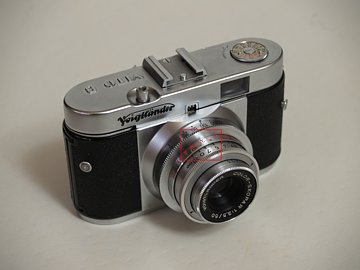
|
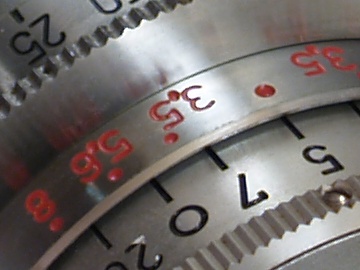
| |
| F=45 mm, aperture priority (±0 EV): F/5.6, 1/5 s, ISO 200; WB by reference; sharpness -2, contrast -1; other settings at default. | ||
|
Even wide open, the image is quite good; for an economy lens — very good. I've seen much worse; check for example the Canon 18-55 mm "kit" zoom. What I find a bit objectionable, though, is the vignetting, quite visible in the corners. Interesting: I would think this is more common at widest angles. It will not always be obvious, and it can be reduced by stepping the aperture down, but still. Overall, except for vignetting not much to complain about, although for tabletop photography I still prefer to use a compact viewfinder camera over a digital SLR — but this is a subject for another article. Overcast outdoors, ISO 200 This time I did some shooting under an overcast, December sky in Lodz, Poland. Without a tripod, I set the CCD gain to ISO 200. |
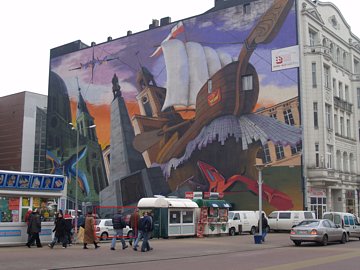
|
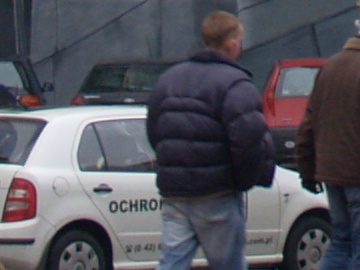
| |
| F = 24 mm, program exposure (-0.3 EV): 1/80 s at F/5.0, ISO 200; sharpness at -2.0, contrast at -1; other settings at default. Click here for the whole, full-size image (5MB). | ||
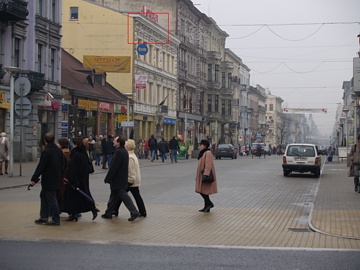
|
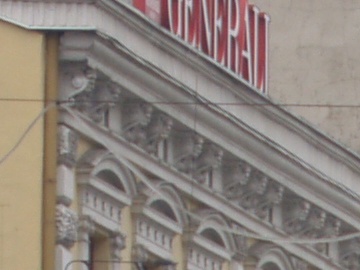
| |
| F = 45 mm, program exposure with (-0.3 EV): 1/125 s at F/6.3, ISO 200; sharpness at -2.0, contrast at -1; other settings at default. | ||
|
A good job again. First of all, I find the ISO 200 setting good enough for general use: no noise worth speaking of, well-adjusted contrast, excellent tonality, and good (if somewhat saturated) colors. With sharpness at -2, there are no visible sharpening artifacts, and, with this subject, there was no detail suitable for giving out excessive noise filtering. Eye candy. ISO 400 in mixed light While waiting for an oil change at my car dealer's, I shot this picture, with quite wide tonal range (indoors and outdoors) and mixed illumination: daylight plus fluorescent. As I didn't have a tripod, I used the ISO 400 setting to avoid camera shake. To get the saturated red I applied a -1.3 EV exposure compensation (I've tried -0.7 EV first, but this was not enough for my taste); this also reduced the highlight burnout in the sky reflection in the rear windshield. |
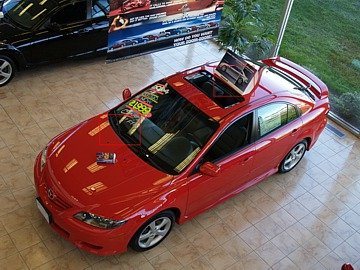
|
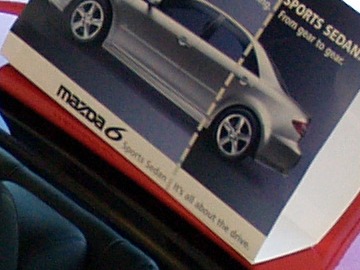
| |
| F=22 mm, program exposure (-1.3 EV): 1/100s at F/6.3, ISO 400, compression 1:4; all other settings at default. |
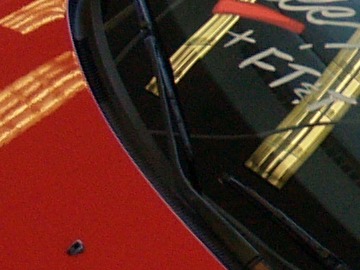
| |
|
The camera did a very nice job here. ISO 400 turns out to be perfectly usable for most applications, in spite of some noise, noticeable in the red hood (the second sample).
For those who complain about noise: get a similar frame shot on an ISO 100 film (no need to go to ISO 400), and use a good scanner without noise filtering to convert it into an 8 MP sample, then have a look. | ||
|
ISO 400 with flash A typical family snapshot, taken at ISO 400 with the FL-20 flash: the Christmas Eve dinner at my wife's parents place in Poland. |

|
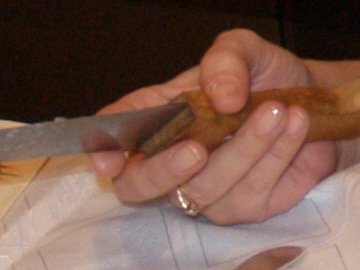
| |
| F=23 mm, program exposure at -1 EV: 1/50 s, F/4.1, ISO 400, contrast -1, sharpness -2, manual focus, SHQ JPEG, other settings at default; FL-20 flash. | ||
|
I like shooting with flash at higher ISO setting to provide some ambient light; the background is not so dark then; that's why I've chosen ISO 400 here, especially not expecting to print the picture in a large size. The exposure compensation of -1 EV was used to avoid burned-out foreground (i.e., my mother-in-law). Skin tones are good, colors OK if a little too vivid; noise, while visible, under control. ISO 800 The fact that Olympus makes this accessible via a custom setting indicates their recognition that the image quality may be not at par with that of ISO 100-400. Still, as ISO 800 can be quite useful in available-light and night shooting, I tried it out. First, an available-light image, shot handheld indoors, about 3 m (10 ft) from a window. While this was noon, the weather outside was quite gloomy (what do you want; this was Poland in December!). |

|
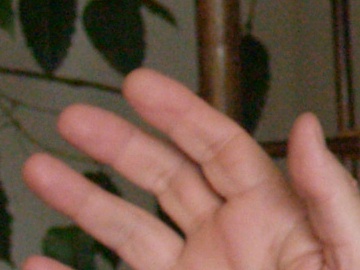
| |
| F=27 mm, program exposure at -0.3 EV: 1/25 s, F/4.4, ISO 800, contrast -1, sharpness -2, HQ JPEG, other settings at default. | ||
|
A nice surprise: while there is some noise clearly visible (I can live with this amount), the colors and tonal scale are right on the spot, soft and pleasing. Certainly, I will not be afraid to use the ISO 800 setting in available light. Another sample, this time under more taxing conditions, ten minutes or so after sunset, gloomy weather again. | ||
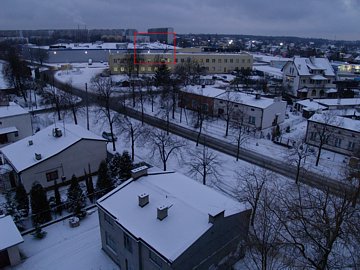
|
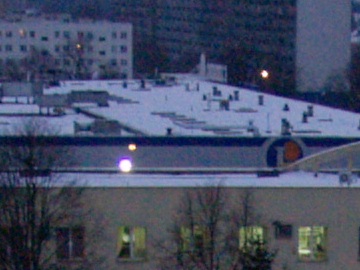
| |
| F=14 mm, program exposure at -0.3 EV: 1/60 s, F/5.0, ISO 800, contrast -1, sharpness -2, HQ JPEG, other settings at default. | ||
|
I'm getting an impression of slightly more noise in this picture; still, it seems to be acceptable (unless your preferences differ, in which case you need to use only ISO 400). The overall bluish cast is OK for this purpose (surprisingly, another shot few seconds later was shifted significantly towards neutral). The horizon is curved, a good demonstration of some distortion present at the shortest focal length. A one-click correction in the Olympus Studio straightened it out, in spite of the file being in the JPEG format. (Does Olympus store lens data in JPEGs too, not just in ORF files, or does it use some default correction then? This I have to investigate further.) Another ISO 800 shot: a street by night. Shooting from hand, I really needed that speed. | ||
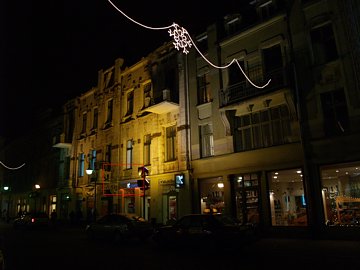
|
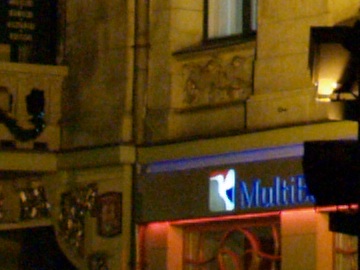
| |
| F=14 mm, program exposure at -0.3 EV: 1/50 s, F/4.5, ISO 800, contrast -1, sharpness -2, SHQ JPEG, other settings at default. The original image is here. | ||
|
The same story: while you can see some noise (look at the area to the left of the bright light sign, or analyze the full frame), the image is quite usable. Just make sure that you do not have to stretch the histogram in postprocessing; this would amplify the effect. Note that the noise seems to have a color (RGB) structure, somewhat different than that of the film grain. Note that there is no purple fringing or chromatic aberration around the burned-out logo (or at any other highlights in the frame); I used to experience that effect quite often in similar pictures taken with use of smaller sensors (C-5050/5060), see below. You may want to compare this image with ones shot with the C-5050WZ at ISO 400, to see what a larger sensor (and two extra years in technology development) have brought. The improvements in both noise (sensor) and chromatic aberration (lens) are clearly visible. Another comparison may me made with the ISO 1600 sample below. ISO 1600 One more sample, this time boosting the ISO to the 1600 setting. Late, January afternoon with daylight filtered through a green tree mostly obscuring the room window: quite dark (EV 5), and the light visibly filtered towards green — that's why I'm setting white balance by reference. | ||

|
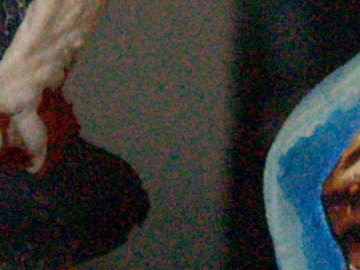
| |
| F=45 mm, aperture priority at -0.3 EV: 1/8 s, F/8, ISO 1600, contrast -1, sharpness -2, HQ JPEG, WB by reference, other settings at default. | ||
|
White balance in this sample is, as expected from my experience with previous Olympus cameras, very good; low-light exposure is good, too. AF did not experience any problems (the camera used the lady's face to lock on). The 1:1 sample shows that the shadows are, however, very noisy, and the noise is, again, of the color type. The situation is equally bad in the brown wood behind. Certainly, I wouldn't print this image at 8x10" or larger, although a 6x8" (15x20 cm) may be acceptable. (I can say that the noise level in this sample is just slightly better than in a Canon 10D at ISO 3200, and much worse than in Canon 300D at ISO 1600.) The Fruit Salad Torture Test Here is a tough subject: fruit slices on a 5300K lightbox. The main source of illumination is the background itself; this puts to test, among others, the anti-ghosting capabilities of the lens. A small positive exposure compensation was applied to counter the bright pieces of background, and a tripod was used. | ||
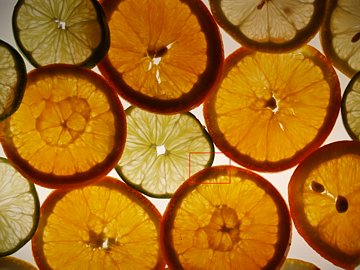
|
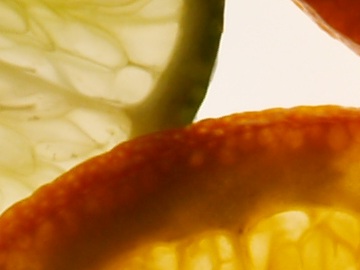
| |
| F=45 mm, aperture priority (+0.3 EV): 1/50 s at F/8, ISO 100, contrast +1, sharpness -2, saturation +1, HQ JPEG, other settings at default. | ||
|
My impression is that some parts of the image suffer from limited amounts of ghosting, especially on the inner rim of the dark peel layer. The same areas also seem to show symptoms of excessive dynamic noise filtering mentioned before. I understand that many reviewers yell "Noise!" any time they see any trace of it in a largely magnified image (magnified with respect to expected print size, that is), and the same sources are now praising Olympus for "very low noise levels". I may be in a minority, preferring some amount of noise instead of the plasticky denoising blur. The aggressive filtering does not show in shots of test targets, and the noise measured on large, smooth surfaces also shows low sigma values, so the measurebators (term courtesy of Ken Rockwell) are happy, but photographers — less so. It just so happens that I rarely need pictures of test targets or uniform mid-tone areas, usually preferring other subjects. The color balance looks good, but knowing the exact color temperature of my source, I shot (among many others) another picture, this time setting the color balance to 5300K. Hard to believe: both images were indistinguishable from each other, even in a flip-flop comparison! The next set of samples are being added to this page almost a year after I started using the E-300, with more than 4000 pictures taken with the camera. These pictures were taken late afternoon in a pumpkin patch near my home in Maryland, and I'm using manual white balance here. | ||
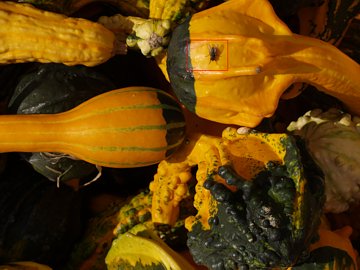
|
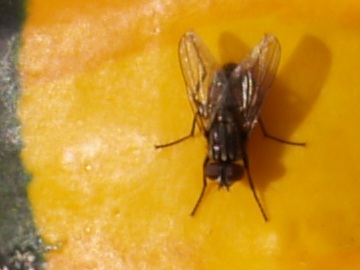
| |
| F=45 mm, program exposure at -0.3 EV: 1/320 s at F/10, ISO 100, contrast -1, sharpness -2, saturation 0, WB at 5300K, HQ JPEG. | ||

|
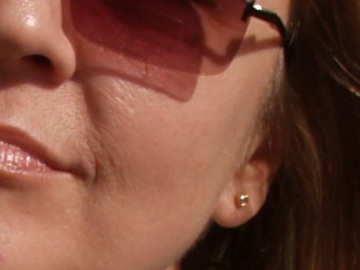
| |
| F=27 mm, program exposure at -0.3 EV: 1/250 s at F/9, ISO 100, contrast -1, sharpness -2, saturation 0, WB at 5300K, HQ JPEG. | ||
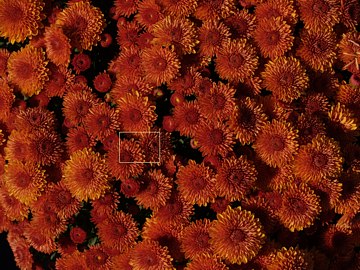
|
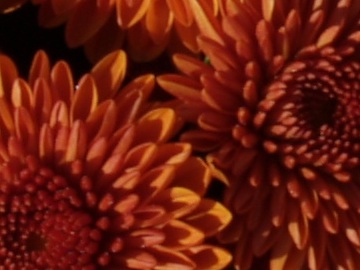
| |
| F=45 mm, program exposure at -1.3 EV: 1/250 s at F/9, ISO 100, contrast -1, sharpness -2, saturation 0, WB at 5300K, HQ JPEG. | ||
|
I think the images speak for themselves. I shot about 50 frames that afternoon, and almost all looked like these. Switching to manual WB gives me control over the color and consistency between frames: the camera will not panic into shifting towards blue because of some pumpkins in the field of view. The skin tones are most pleasing, and the lens, especially stopped down, is really sharp. (Remember that the in-camera sharpness was set to minimum, and no sharpening was applied to full-scale samples at the right.) Note that in the last picture I applied a strong exposure compensation, -1.3 EV. But of course, I didn't want the flowers to come out at the 18% gray level. Don't expect the camera automation to do it for you. The highly-saturated petals still do not show overload in the red channel. (Two more samples from this session can be found in my 55-200 mm Sigma lens review.) To sum it up, after a year with the camera I'm even happier with its performance than I was in the first weeks. Maybe I have learned to use its advantages and work around the limitations? One way or another, this is one bundle of image quality. Conclusions The inexpensive, bundled 14-45 mm lens is good, in spite of exhibiting some distortion at the widest setting, and slight vignetting when wide open. The "economy" lenses offered by Canon and Nikon are no match here, although I did not have an opportunity to try ones offered by Pentax and Minolta. The imager does an excellent job at ISO 100 and 200, good at ISO 400, acceptable at ISO 800, and a very noisy one at ISO 1600 (colors and tonality still remain OK there). The last setting is really usable in emergencies only, unless you convert images to monochrome and/or accept the "grain" (remember the super-grain technique of yesteryear?). I'm not blaming Olympus for the high-ISO noise, however, as they clearly specify the camera as offering the ISO 100-400 range, with higher settings available only as an extra. To the contrary, my only complaint is excessive dynamic noise filtering at low ISO, visible under some circumstances. This can be a problem in large prints of some images, and I would be very happy to see the filtering reduced (or, preferably, adjustable). The white balance is among the best, and setting it by reference dealt just fine with a number of tricky situations. Still, as always, setting the WB manually delivers best results. Exposure seems to be consistent, but using exposure compensation will, like with any camera, film or digital, greatly improve your results. Overall, I'm not disappointed with the performance of the camera/lens combination. I was expecting Olympus not to cut corners on image quality, and they delivered, in spades. More samples
|

|
My other articles related to the |
|
Evolt® and Olympus® are registered trademarks of Olympus Corporation.
This page is not sponsored or endorsed by Olympus (or anyone else) and presents solely the views of the author. |
| Home: wrotniak.net | Search this site | Change font size |
| Posted 2004/12/17; last updated 2007/08/13 | Copyright © 2004-2007 by J. Andrzej Wrotniak |